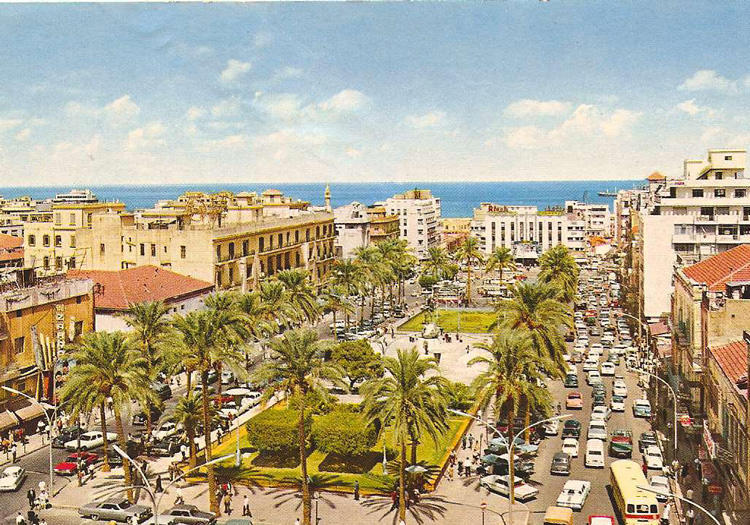
Beirut
Martyrs’ Square and the Grand Axis of Beirut: International Urban Design Ideas Competition
Dome City Center, Martyrs’ Square
May 19–June 4, 2005
“The Underwater Venice of Beirut,” “The Urban Chameleon,” and “Berytus: Rose of the Mediterranean” are just some of the submitted titles that reflect the substance — or lack of it — in Martyrs’ Square and the Grand Axis of Beirut: International Urban Design Ideas Competition. Sponsored and organized by Solidere, a private multibillion-dollar mega-corporation charged with the reconstruction of Beirut following fifteen years of war in Lebanon, the competition is meant to collect ideas and decide the future of what is arguably the most important space in Beirut, and possibly in all of Lebanon: Martyrs’ Square. The 122 entries, from forty countries, are presented as posters and displayed like science fair projects on the multiple levels of Joseph Philippe Karam’s Beirut City Center Complex, known in Lebanese vernacular as the Bubble, the Dome, or the Egg.
Of the organizers’ thirteen goals and objectives — printed on walls near the entrance of the Dome — among the most peculiar is “to create a landmark, high rise zone in the northeastern part of the sector, marking the termination of the coastal highway and the gateway entrance to the city center.” This aspiration connects smoothly to another objective, “to help reposition Beirut to compete with other cities in the region.” Dubai would be a good guess if you were wondering what they were referring to by “other cities in the region.” Oddly enough, some proposals actually suggested the construction of “Burj Square,” a provincial skyscraper monstrosity superimposed on Martyrs’ Square — obviously referencing Dubai’s Burj Tower.
Even more disturbing is Solidere’s “high rise zone” plan. Why, when Beirut offers such a unique tabula rasa and the opportunity to reinvent the space with post-post-postmodern landmarks designed by the world’s finest architectural and engineering firms, are design proposals supposed to be limited to that modernist symbol of power and finance, the high rise? The stipulation has resulted in several projects that mark the area’s northeastern corner with a cluster of skyscrapers straight out of Houston or Dallas. Maybe Solidere envisions a heavily commercial coastline for Beirut, but surely alternatives to the high rise exist in creating a viable, public waterfront. This short-sightedness is just one example of the strange and significant conceptual flaws plaguing the competition, which itself demonstrates a monumental lack of imagination.
Also disappointing is that few of the entrants submitted proposals that critically question the organizers’ objectives, creatively circumvent the guidelines, or trenchantly reevaluate the political, social, historical, aesthetic and psychological values of Martyrs’ Square. Most of the offerings — complete with knock-your-socks-off titles — favor developing the space into a capital-driven consumerist center for big business folk and tourists, with a bit of cafe culture and even casinos. Few proposals envision the participation of weirdos from other sectors of society and the margins of Lebanon’s citizenry in the public arena, or the political activity that constitutes the square’s identity. Whatever happened to harnessing the political significance of the square in order to facilitate civic responsibility and encourage greater public consciousness among the Lebanese? The failure of entrants and organizers to acknowledge such a basic necessity reflects the most serious and conspicuous dearth of substance and vision in the exhibition. To their credit, some — very, very few — proposals responded to this pressing need.
The problems with the entries — which are always unpredictable — are the result of the competition’s deeper structural and conceptual problems. One is led to understand that the results of this competition are entirely inconsequential. What seems more central to the organizers’ concerns are marketing strategies for their own projects — and validating those strategies by holding an international competition about ideas for the future of central Beirut. Solidere’s attempt to appear democratic, or inclusive, or politically correct, by sponsoring this competition is obscured by the subtext that has made the corporation so controversial in the first place: Solidere owns the entire plot of land in question, making it private property. Only they can decide what to do with it — or who will inhabit it.
This competition is supposed to help Solidere shed its image as a closed, hegemonic, monopolistic fortress, giving it a credibility that its lacked for at least the past ten years. To unilaterally construct a public space as politicized and important as Martyrs’ Square according to a privately chosen design would seem politically untenable. Although the idea of a transparent process to determine the future of Beirut’s city center is admirable, in reality this exhibit is unfortunately nothing more than affected patronage.